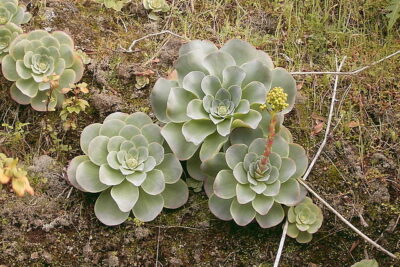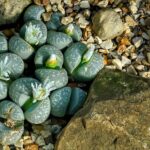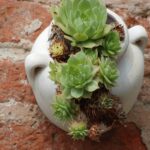
Indoor Succulent Gardening: Best Tall Succulents for Thriving Indoors

Indoor gardening has become increasingly popular in recent years, as more and more people are embracing the benefits of bringing nature into their homes. One type of plant that has gained particular attention is succulents. Known for their ability to thrive in dry conditions and their unique, fleshy appearance, succulents have become a favorite choice for indoor gardening enthusiasts.
We will focus specifically on tall succulents that are well-suited for indoor environments. We will explore the different varieties of tall succulents available, discussing their unique features and care requirements. Whether you are a seasoned indoor gardener looking to expand your collection or a beginner interested in starting your own succulent garden, this article will provide valuable information and tips to help you create a thriving indoor succulent garden.
- Choose tall succulents that thrive in low light conditions, such as snake plants and ZZ plants
- Place your succulents near a window that receives indirect sunlight for at least a few hours a day
- Use well-draining soil specifically formulated for succulents to prevent root rot
- Water your succulents sparingly, allowing the soil to dry out completely between waterings
- Provide adequate air circulation by placing a small fan near your succulents
- Fertilize your tall succulents with a diluted succulent fertilizer once every few months
- Prune your succulents to maintain their desired height and shape
- Protect your tall succulents from extreme temperature fluctuations and drafts
- Rotate your succulents regularly to ensure even growth and prevent leaning or stretching towards the light
- Keep an eye out for signs of pests or diseases and take immediate action to prevent their spread
- Frequently Asked Questions
Choose tall succulents that thrive in low light conditions, such as snake plants and ZZ plants
When it comes to indoor succulent gardening, choosing tall succulents that can thrive in low light conditions is essential. Not all succulents are suitable for growing indoors, especially if you have limited sunlight exposure. However, there are some varieties that can adapt well to low light environments and still thrive. Two excellent options for tall succulents that can flourish indoors are snake plants and ZZ plants.
Snake Plants
Snake plants, also known as Sansevieria or mother-in-law's tongue, are popular choices for indoor gardening due to their adaptability and low maintenance requirements. These succulents have long, upright leaves that grow vertically, making them perfect for adding height to your indoor garden.
Snake plants are particularly well-suited for indoor environments as they can tolerate low light conditions and infrequent watering. They are known for their ability to purify the air by removing toxins, making them an excellent choice for improving indoor air quality.
ZZ Plants
ZZ plants, scientifically known as Zamioculcas zamiifolia, are another great option for tall succulents that can thrive indoors. These plants have glossy, dark green leaves that grow in an upright fashion, adding an elegant touch to any indoor space.
 Succulents: Indoor or Outdoor Plants?
Succulents: Indoor or Outdoor Plants?Similar to snake plants, ZZ plants are well-adapted to low light conditions and require minimal watering, making them perfect for indoor gardening. They are known for their resilience and ability to withstand neglect, making them an excellent choice for beginners or those with busy schedules.
Considerations for Indoor Tall Succulent Gardening
When choosing tall succulents for indoor gardening, it's important to consider a few factors to ensure their success:
- Lighting: Select succulents that can tolerate low light conditions, as they are more likely to thrive indoors.
- Watering: Opt for succulents that require infrequent watering to prevent overwatering and root rot.
- Container: Choose a well-draining container with sufficient depth to accommodate the tall growth of these succulents.
- Soil: Use a well-draining soil mix specifically formulated for succulents to prevent waterlogged roots.
- Placement: Find a location in your home that receives some natural light, such as near a window, to provide the succulents with the necessary light they need.
By considering these factors and selecting tall succulents that are well-suited for indoor environments, you can create a thriving indoor succulent garden that adds beauty and greenery to your living space.
Place your succulents near a window that receives indirect sunlight for at least a few hours a day
When it comes to indoor succulent gardening, one of the most crucial factors to consider is the amount of sunlight your plants receive. Succulents thrive in bright light, but they can get sunburned if exposed to direct, intense sunlight for long periods. Therefore, it is essential to find the right balance.
Choose a window in your home that receives indirect sunlight for at least a few hours a day. This will provide your succulents with the necessary light they need to thrive. South or east-facing windows are typically ideal, as they offer the right amount of sunlight without the risk of scorching your plants.
However, if you don't have access to a window with indirect sunlight, don't worry! You can still grow succulents indoors by using artificial grow lights. These lights mimic the natural spectrum of sunlight and provide your plants with the necessary light energy for photosynthesis.
 Growing Trunked Succulents Indoors: A Guide
Growing Trunked Succulents Indoors: A GuideTip: Keep an eye on your succulents and observe how they respond to the light conditions. If you notice that their leaves are stretching or leaning towards the light source, it's an indication that they need more sunlight. On the other hand, if you see signs of sunburn, such as brown or yellow patches on the leaves, it's a sign that they are getting too much direct sunlight.
Best Tall Succulents for Thriving Indoors
Not all succulents are suitable for indoor gardening, especially when it comes to taller varieties. Some succulents naturally grow taller than others, and their unique characteristics make them better suited for thriving indoors. Here are some of the best tall succulents that you can consider for your indoor garden:
- Snake Plant (Sansevieria Trifasciata): Also known as Mother-in-law's Tongue, the Snake Plant is a popular choice for indoor gardening. It has long, upright leaves that can reach several feet in height. Snake Plants are known for their air-purifying qualities and ability to thrive in low light conditions.
- Ponytail Palm (Beaucarnea Recurvata): Despite its name, the Ponytail Palm is not a true palm but a succulent. It features a unique, bulbous trunk and long, thin leaves that resemble a ponytail. This succulent can grow up to several feet tall, making it a stunning addition to any indoor garden.
- Yucca (Yucca Elephantipes): Yucca is a striking succulent with sword-shaped leaves that can grow up to several feet in height. It is known for its architectural beauty and resilience, making it a perfect choice for indoor gardening.
- Aloe Vera (Aloe Barbadensis): Aloe Vera is a versatile succulent with fleshy, spiky leaves that can grow tall under the right conditions. It not only adds a touch of green to your indoor space but also offers various medicinal benefits.
These tall succulents can add height, texture, and visual interest to your indoor garden. Remember to provide them with the right amount of light, water, and well-draining soil to ensure their health and longevity.
Use well-draining soil specifically formulated for succulents to prevent root rot
When it comes to indoor succulent gardening, one of the key factors for their success is using well-draining soil. Succulents, known for their ability to store water in their leaves, stems, and roots, are highly susceptible to root rot if their soil retains too much moisture. To ensure that your succulents thrive indoors, it is essential to use soil specifically formulated for succulents.
Succulent soil is typically a blend of materials such as sand, perlite, and peat moss, which promote good drainage and aeration. These ingredients allow excess water to flow through the soil, preventing the roots from sitting in damp conditions for extended periods. By providing a well-draining environment, you minimize the risk of root rot and create an ideal growing medium for your indoor succulent garden.
Choose tall succulents for a captivating indoor display
While there are numerous succulent varieties to choose from, opting for tall succulents can add an extra layer of visual interest to your indoor garden. Tall succulents not only make a stunning focal point but also create an illusion of height, making your space appear larger and more dynamic. Here are some of the best tall succulents that thrive indoors:
 Choosing Low-Light Succulents: A Guide to Thriving Indoors
Choosing Low-Light Succulents: A Guide to Thriving Indoors- Sansevieria (Snake Plant): Known for its upright, sword-like leaves, the snake plant is one of the most popular choices for indoor gardening. It tolerates low light conditions and requires minimal maintenance, making it an excellent choice for beginners.
- Euphorbia tirucalli (Pencil Cactus): With its slender, pencil-like branches, this succulent adds a unique architectural element to any indoor space. It prefers bright light and infrequent watering.
- Kalanchoe beharensis (Elephant's Ear): This succulent boasts large, velvety leaves with an interesting texture. It thrives in bright light and prefers drier conditions, making it a great choice for indoor succulent gardening.
These tall succulents not only provide a striking visual appeal but also require minimal care, making them ideal for indoor gardening enthusiasts of all skill levels. Remember to place them in bright, indirect light and allow the soil to dry out between waterings to ensure their long-term health and vitality.
Water your succulents sparingly, allowing the soil to dry out completely between waterings
When it comes to indoor succulent gardening, one of the most important things to keep in mind is to water your succulents sparingly. Succulents store water in their leaves and stems, making them drought-tolerant plants. Therefore, overwatering can be detrimental to their health and may lead to root rot.
To ensure the well-being of your indoor succulents, allow the soil to dry out completely between waterings. This will mimic the natural conditions they would experience in their native habitats.
It's crucial to pay attention to the signs your succulents give you. If the leaves start to look plump and feel soft or mushy, it's a sign of overwatering. On the other hand, if the leaves become wrinkled or shriveled, it's an indication that your succulent needs water.
Choosing the right tall succulents for indoor gardening
Not all succulents are created equal when it comes to indoor gardening. Some succulents are better suited for thriving indoors, particularly taller varieties that can add height and visual interest to your indoor space.
Here are some of the best tall succulents that are well-suited for indoor gardening:
- Snake Plant (Sansevieria) - Snake plants are known for their striking, sword-shaped leaves that come in various shades of green. They are incredibly resilient and can tolerate low light conditions, making them an excellent choice for indoor gardening.
- Zebra Cactus (Haworthia) - With its distinctive white stripes on dark green leaves, the zebra cactus is a visually appealing succulent. It is a slow-growing plant that thrives in bright, indirect light, making it perfect for indoor spaces.
- Ponytail Palm (Beaucarnea recurvata) - Despite its name, the ponytail palm is not a true palm but rather a succulent. This tall succulent features long, thin leaves that cascade downward, resembling a ponytail. It prefers bright, indirect light and can be an eye-catching addition to any indoor garden.
These tall succulents not only bring a touch of greenery to your indoor space but are also relatively low-maintenance, making them perfect for beginners in indoor gardening.
 Growing Aloe Vera Indoors: Tips for Cultivating Succulent Houseplants
Growing Aloe Vera Indoors: Tips for Cultivating Succulent HouseplantsProvide adequate air circulation by placing a small fan near your succulents
Why is air circulation important for indoor succulent gardening?
Adequate air circulation is crucial for the health and vitality of indoor succulents. Succulents are adapted to dry and arid environments, and they thrive in conditions with good air movement. Proper air circulation helps prevent the buildup of excess moisture, which can lead to fungal diseases and rot.
Indoor environments often lack natural air movement, especially in rooms with closed windows and doors. By placing a small fan near your succulents, you can simulate a gentle breeze and promote air circulation. This helps to prevent stagnant air pockets around the plants and ensures that excess moisture evaporates efficiently.
How to provide adequate air circulation for your indoor succulents
Here are some tips to ensure proper air circulation for your indoor succulents:
- Position a fan: Place a small fan near your succulents, ensuring that it provides a gentle airflow without directly blowing onto the plants. Adjust the fan's speed and direction to create a mild breeze.
- Open windows and doors: When weather permits, open windows and doors to allow fresh air to circulate throughout the room. This can help improve air quality and prevent the buildup of stagnant air.
- Use oscillating fans: If possible, opt for oscillating fans that can rotate and distribute air in multiple directions. This helps to ensure that all areas around the succulents receive adequate air movement.
The best tall succulents for thriving indoors
When choosing tall succulents for indoor gardening, it's essential to select varieties that can adapt well to indoor conditions. Here are some excellent options:
- Snake Plant (Sansevieria trifasciata): Known for its architectural leaves and ability to tolerate low light, the Snake Plant is an ideal choice for indoor gardening. It can grow tall and adds a touch of elegance to any space.
- Zebra Plant (Haworthia fasciata): This succulent features striking zebra-like stripes on its leaves. It thrives in bright, indirect light and can grow tall, making it a visually appealing addition to your indoor garden.
- Madagascar Palm (Pachypodium lamerei): With its unique trunk and spiky leaves, the Madagascar Palm is a stunning tall succulent. It requires bright light and well-draining soil, making it a bit more challenging to care for but worth the effort.
By providing adequate air circulation and choosing the right tall succulents, you can create a thriving indoor succulent garden that adds beauty and serenity to your living space.
Fertilize your tall succulents with a diluted succulent fertilizer once every few months
When it comes to indoor succulent gardening, one important aspect to consider is fertilizing your tall succulents. Providing them with the right nutrients is essential for their growth and overall health. One way to do this is by using a diluted succulent fertilizer.
 Can You Successfully Grow Lotus Lithops Succulents Indoors?
Can You Successfully Grow Lotus Lithops Succulents Indoors?A diluted succulent fertilizer can help replenish the nutrients that may be lacking in your indoor environment. It is recommended to fertilize your tall succulents once every few months, especially during their active growing season.
When choosing a succulent fertilizer, look for one that is specifically formulated for succulents. These types of fertilizers usually have a higher concentration of nutrients that are beneficial for succulent growth. Additionally, opt for a liquid fertilizer as it is easier to apply and can be absorbed by the plants more efficiently.
How to fertilize your tall succulents
Follow these steps to fertilize your tall succulents effectively:
- Choose the right time: Fertilize your succulents during their active growing season, which is usually spring and summer. Avoid fertilizing during the dormant period as the plants may not be able to absorb the nutrients effectively.
- Dilute the fertilizer: Always dilute the succulent fertilizer according to the instructions on the packaging. Using a concentrated fertilizer can harm your plants.
- Water the soil: Before applying the fertilizer, make sure the soil is moist. This will help prevent any potential damage to the roots.
- Apply the fertilizer: Use a watering can or spray bottle to apply the diluted fertilizer to the soil around the base of the succulent. Avoid getting the fertilizer on the leaves or stems, as it can cause burns or damage.
- Monitor and adjust: Keep an eye on your succulents after fertilizing. If you notice any signs of overfertilization, such as burnt or discolored leaves, reduce the amount of fertilizer or frequency of application.
Remember, fertilizing your tall succulents is just one part of their care routine. It's important to provide them with adequate sunlight, well-draining soil, and proper watering to ensure they thrive indoors.
Prune your succulents to maintain their desired height and shape
When it comes to indoor succulent gardening, one of the key factors to consider is the height and shape of your succulents. While many succulents naturally grow low and compact, there are also some tall varieties that can add an interesting vertical element to your indoor garden. But how do you ensure that these tall succulents thrive indoors while maintaining their desired height and shape?
The answer lies in regular pruning. Pruning not only helps to control the size and shape of your succulents but also encourages new growth and keeps them healthy. Here are some tips for pruning your tall succulents:
 Can You Keep Succulents Indoors Year-Round?
Can You Keep Succulents Indoors Year-Round?1. Use clean, sharp tools
Before you start pruning your succulents, make sure you have clean and sharp tools. This will help prevent the spread of diseases and ensure clean cuts, promoting faster healing for your plants. Sterilize your pruning shears or scissors with rubbing alcohol or a mixture of bleach and water before each use.
2. Identify the areas to prune
Take a close look at your tall succulent and identify the areas that need pruning. Look for leggy stems, overgrown branches, or any dead or damaged parts. These are the areas you will focus on during the pruning process.
3. Prune during the active growing season
Timing is crucial when it comes to pruning your succulents. It's best to prune during the active growing season, which is typically spring or early summer. This allows your succulents to recover quickly and promotes healthy new growth.
4. Trim from the base or node
When pruning your tall succulents, make sure to trim them from the base or just above a node. Nodes are the points where leaves or branches emerge from the stem. By trimming above a node, you encourage new growth and prevent your succulent from becoming top-heavy.
5. Remove any dead or damaged parts
As you prune, be sure to remove any dead or damaged parts of your succulent. These parts can attract pests or diseases and hinder the overall health of your plants. Cutting them off will promote healing and prevent further damage.
6. Step back and assess
After pruning, take a step back and assess the overall shape and height of your succulents. If necessary, you can continue pruning to achieve your desired height and shape. Remember to take it slowly and make small adjustments at a time to avoid over-pruning.
By following these pruning tips, you can maintain the desired height and shape of your tall succulents while ensuring they thrive indoors. Regular pruning will not only enhance the aesthetic appeal of your indoor garden but also contribute to the overall health of your succulents.
 Indoor vs Outdoor: Ideal Growing Environments for Succulents
Indoor vs Outdoor: Ideal Growing Environments for SucculentsProtect your tall succulents from extreme temperature fluctuations and drafts
If you want your indoor succulent garden to thrive, it's important to pay attention to the temperature and drafts in your home. Tall succulents, in particular, are more sensitive to extreme temperature changes and drafts, which can cause stress and damage to the plants. Here are some tips to help you protect your tall succulents from these potential hazards:
1. Find the right spot
When choosing a spot for your tall succulents, look for an area in your home that receives plenty of bright, indirect sunlight. Succulents love sunlight, but direct sunlight for long periods can scorch their leaves. Placing them near a window that gets morning or afternoon sun is ideal.
2. Avoid cold drafts
Succulents are native to warm and arid regions, so they prefer temperatures between 60°F (15°C) and 80°F (27°C). Avoid placing your tall succulents near windows or doors that are frequently opened during cold winter months. Cold drafts can quickly drop the temperature and cause the plants to suffer.
3. Protect from heat sources
Succulents are also sensitive to extreme heat. Keep your tall succulents away from radiators, heating vents, and other heat sources that can dry out the air or create hotspots. High temperatures can lead to dehydration and damage the leaves.
4. Provide insulation during winter
If you live in a region with cold winters, it's important to take extra precautions to protect your tall succulents. Consider using insulation materials, such as bubble wrap or horticultural fleece, to create a barrier between the plants and the cold window panes. This will help maintain a more stable temperature and prevent frost damage.
5. Monitor humidity levels
Succulents thrive in low humidity environments, so it's best to keep the humidity levels in your home low. Avoid placing your tall succulents in areas with high humidity, such as bathrooms or kitchens, as it can lead to fungal diseases and rot. Good air circulation is also important to prevent moisture buildup around the plants.
 Optimal Indoor Lighting for Succulents: Sunlight or Not?
Optimal Indoor Lighting for Succulents: Sunlight or Not?By following these tips, you can create a suitable environment for your tall succulents to thrive indoors. Remember to regularly check for signs of stress, such as wilting or discoloration, and make adjustments accordingly. With proper care, your tall succulents will not only survive but also flourish in your indoor garden.
Rotate your succulents regularly to ensure even growth and prevent leaning or stretching towards the light
When it comes to indoor succulent gardening, one of the key factors for success is providing proper sunlight to your plants. Succulents thrive in bright light conditions, but if they are not receiving light evenly, they might start leaning or stretching towards the light source.
To prevent this, it is essential to rotate your succulents regularly. By rotating them, you ensure that all parts of the plant receive an equal amount of sunlight. This helps in promoting even growth and prevents the succulent from becoming lopsided or elongated.
Rotate your succulents at least once every two weeks to achieve the best results. You can do this by simply turning the pots or containers in a clockwise or counterclockwise direction. If you have larger succulents planted directly in the ground, gently turn the entire plant in the same manner.
Pro Tip: While rotating your succulents, take the opportunity to examine the leaves and stems for any signs of pests or disease. Early detection can help you prevent any potential issues from spreading and ensure the health of your succulents.
Keep an eye out for signs of pests or diseases and take immediate action to prevent their spread
Signs of Pests or Diseases
When it comes to indoor succulent gardening, it's important to keep a vigilant eye out for signs of pests or diseases. These unwelcome visitors can quickly wreak havoc on your beloved plants if left unchecked. Here are some common signs to watch out for:
 Can Succulents Thrive Indoors Without Sunlight?
Can Succulents Thrive Indoors Without Sunlight?- Yellowing or discolored leaves: This could be a sign of various pests, such as mealybugs or spider mites. It can also indicate a fungal or bacterial infection.
- Sticky residue or webbing: If you notice a sticky residue on your succulents' leaves or see webbing, it may be a sign of aphids or spider mites.
- Wilting or drooping: While overwatering is a common cause of wilting, it's also essential to check for signs of root rot or fungal diseases.
- Black or brown spots: These can indicate various fungal diseases, such as leaf spot or powdery mildew.
- Holes in leaves: Small holes in leaves may be a sign of chewing pests like caterpillars or snails.
Immediate Action
If you spot any of these signs, it's crucial to take immediate action to prevent further spread and damage. Here are some steps you can take:
- Isolate affected plants: Remove any affected succulents from the rest of your indoor garden to prevent the spread of pests or diseases.
- Inspect the plants carefully: Examine the affected plants thoroughly to identify the specific pest or disease. This will help you choose the most appropriate treatment.
- Use natural remedies or insecticides: Depending on the severity of the infestation or infection, you can opt for natural remedies like neem oil or insecticidal soap. In more severe cases, you may need to use chemical insecticides, but be cautious and follow the instructions carefully.
- Trim and dispose of heavily affected foliage: If certain parts of the succulent are heavily damaged or diseased, it's best to trim them off and discard them properly to prevent further spread.
- Monitor and repeat treatment if necessary: Keep a close eye on your plants after treatment and repeat the process if needed. It's important to be persistent in eradicating pests or diseases.
Remember, prevention is always better than cure. Regularly inspecting your indoor succulents and maintaining a clean environment will help minimize the risk of pests or diseases. By acting promptly and using appropriate treatments, your succulents can thrive and continue to beautify your indoor space.
Frequently Asked Questions
1. Can succulents thrive indoors?
Yes, many succulents can thrive indoors as long as they receive adequate light and are planted in well-draining soil.
2. What are the best tall succulents for indoor gardening?
Some popular tall succulents for indoor gardening include the snake plant, jade plant, and aloe vera.
3. How much light do indoor succulents need?
Most succulents require bright, indirect light for at least 6 hours a day, so placing them near a sunny window is ideal.
4. How often should I water indoor succulents?
Succulents have low water needs and should be watered sparingly. It's best to allow the soil to dry out between waterings, typically every 1-2 weeks.
 Can Succulents Flourish with Grow Lights?
Can Succulents Flourish with Grow Lights?If you want to read more articles similar to Indoor Succulent Gardening: Best Tall Succulents for Thriving Indoors, you can visit the Indoor and Outdoor Care category.






You Must Read